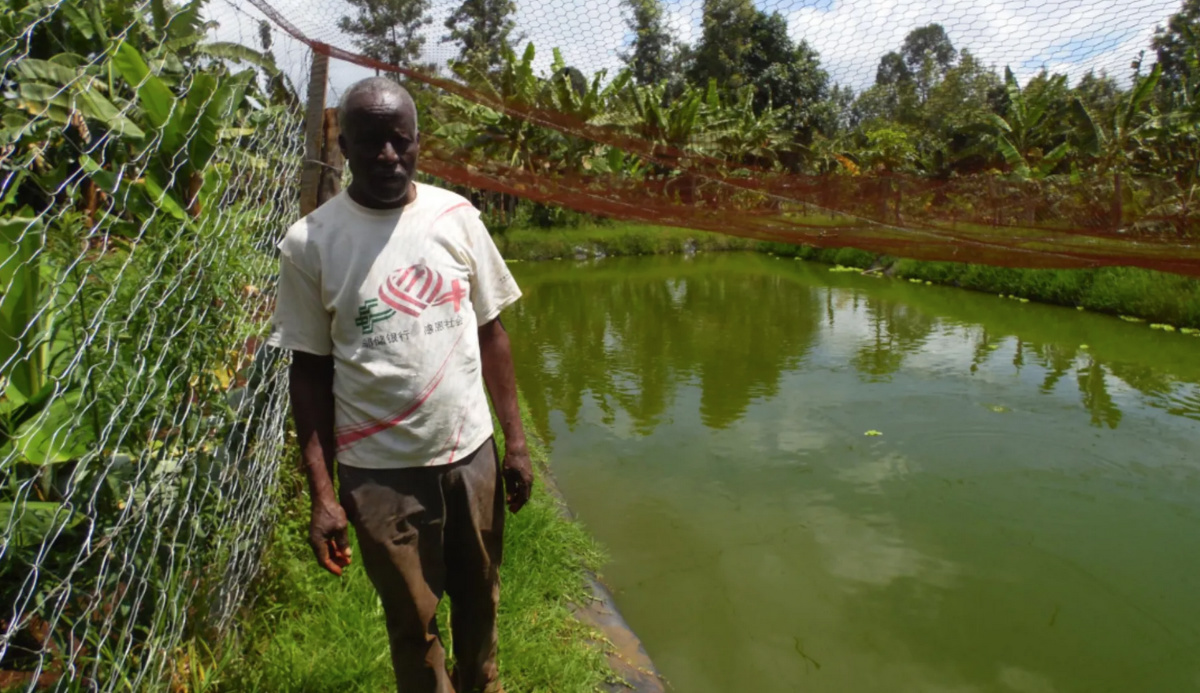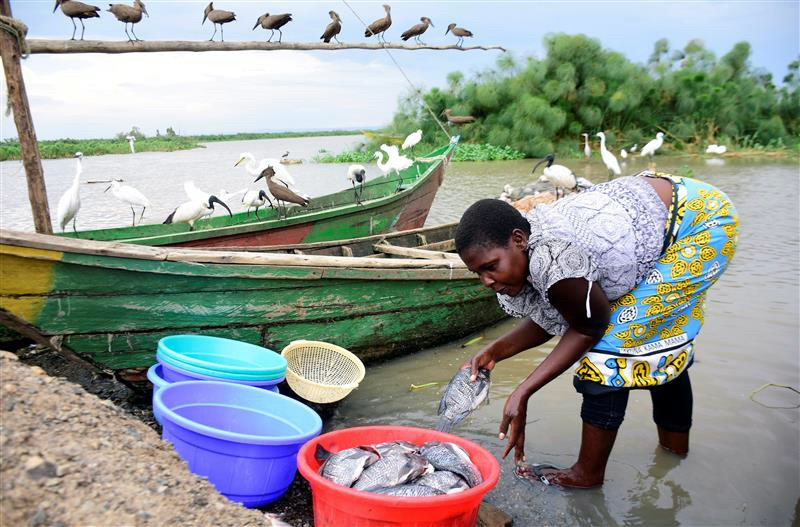
CAROLINE WAMBUI, of the Thomson Reuters Foundation, reports on how a Kenya county is helping farmers build fish ponds in a bid to even out water availability and diversify incomes…
Kibingo, Kenya
Thomson Reuters Foundation
When farmer Elijah Murithi grew bananas in the 1980s and 1990s, central Kenya’s increasingly erratic weather meant he could rarely make a steady income from the thirsty crop.
Prolonged dry spells killed Murithi’s young plants and long, intense rainy periods produced a glut of bananas that forced him to lower his prices to sell them in the market.
Even when he shifted to coffee, which needs less water, the farmer still struggled to produce reliable yields.
But that changed in 2021 when he added an unusual crop to his farm: fish.

Elijah Murithi poses for a photo next to his fish pond in Kibingo, central Kenya, on 7th December, 2022. PICTURE: Thomson Reuters Foundation/Caroline Wambui
A fish pond – filled with more than 1,500 tilapia – now allows him to harvest rainwater during heavy rains and use some of it to irrigate his crops when dry spells hit, the farmer explained.
Now, he said, he makes a decent living through drought or downpours, growing coffee and vegetables year-round while making extra income selling fish.
“This really worked to my advantage.”
– farmer Elijah Murithi
“This really worked to my advantage,” he said, explaining how water he regularly drains from his 10-by-25-metre fishpond, built just uphill from his coffee plantation, allows him to water other crops on his 0.5-hectare farm in Kibingo, about 130 kilometres north-east of Nairobi.
Since he started fish farming in April last year, Murithi said his coffee harvests have more than doubled, to 2,000 kilograms a year, and his overall income has tripled.
As the East African country grapples with climate swings that batter crops and choke incomes – including a current drought that is the worst in four decades – some farmers are discovering that adding fish to their farms can help with water storage, make their diets more nutritious, and boost earnings.
Since 2019, the Kirinyaga county government has been helping farmers build fish ponds under an economic stimulus programme.
The fisheries department said it has so far supported about 20 farming groups and more than 1,350 individuals. It did not provide any information about the cost of the initiative.
The county covers the cost of a pond liner, and, for the first year, pays for baby fish – also called fingerlings – and enough fish feed to sustain them until they mature.
Kirinyaga’s government said in October it was working to increase annual fish production from 29 tonnes – with a value of 12.8 million Kenyan shillings ($US104,000) – to 62 tonnes.

A fishmonger, prepares fish at Dunga beach on the shores of Lake Victoria in Kisumu, Kenya, on 18th March, 2020. PICTURE: Reuters/James Keyi
At first, most farmers resisted the idea of raising fish in an often-parched region, said Harrison Mwangi, chairperson of the Kamwaka Self Help farmers group, which has 26 members.
He said the prospect was alien to many of the members, who instead thought they would have better results raising chickens.
But after county officials provided training on how to successfully raise fish – as well as help with key costs – many farmers have given it a try.
Ultimately, Mwangi said his group decided to convert a field of napier grass at a farm owned by one of its members – a field that was producing less and less fodder, especially during the dry season – into a fish pond at the start of 2021.
Through the rest of year, the farmers then sold 17,000 shillings ($US137) worth of fish to people visiting the farm or at local markets, Mwangi said, describing the sales as “quite encouraging” for a first harvest.
“The group could not have found a better way to utilise the farm,” he said, explaining how farming fish was easier than managing other livestock.
The Kamwaka farmers – who each have an annual income of between 100,000 – 150,000 shillings ($US807 – $US1,211) – should see even higher earnings from fish farming in the future as their stocks multiple, according to Mwangi.
John Wilson, the manager of Mwea Aquaculture Farm, which raises tilapia and catfish and also offers training to farmers, said fish farming was not only good business but also provided an alternative source of protein for Kenyans.
Apart from the challenge of convincing drought-hit farmers in Kenya that fish are a realistic future crop, the project still has a few other kinks to work out, Murithi and Mwangi said.
While the ponds can be a buffer against drought by storing rain to be used for irrigation in the dry season, farmers hit with particularly extended dry spells can struggle to find ways to top them up.
Murithi said he has at times replenished his pond using agricultural water rations provided by the county to help farmers in dry periods.
We rely on our readers to fund Sight's work - become a financial supporter today!
For more information, head to our Subscriber's page.
Meanwhile, the Kamwaka farmers have to pump clean water from nearby rivers to their pond on a weekly basis during drought periods, using a generator which is costly to run, Mwangi said.
Another challenge facing fish farmers is how to deal with a surplus of fish now filling local markets as more people take up raising them, according to industry insiders.
“Farmers need to be aggressive in looking for a market for their produce, and should not wait for the county government to do the marketing for them,” said Michael Manyeki, a fingerling producer in Sagana, a small industrial town in Kirinyaga.
For Ntiba Micheni, a professor of marine and fisheries biology at Nairobi University, the solution to excess production is getting more Kenyans to think of fish as dinner in a country where eating them is not common everywhere.
“If there is no robust ‘Eat More Fish’ campaign for young children, for schools, and for communities, fish [eating] will forever remain a challenge,” said Micheni, a former official at the government’s department for fisheries.






